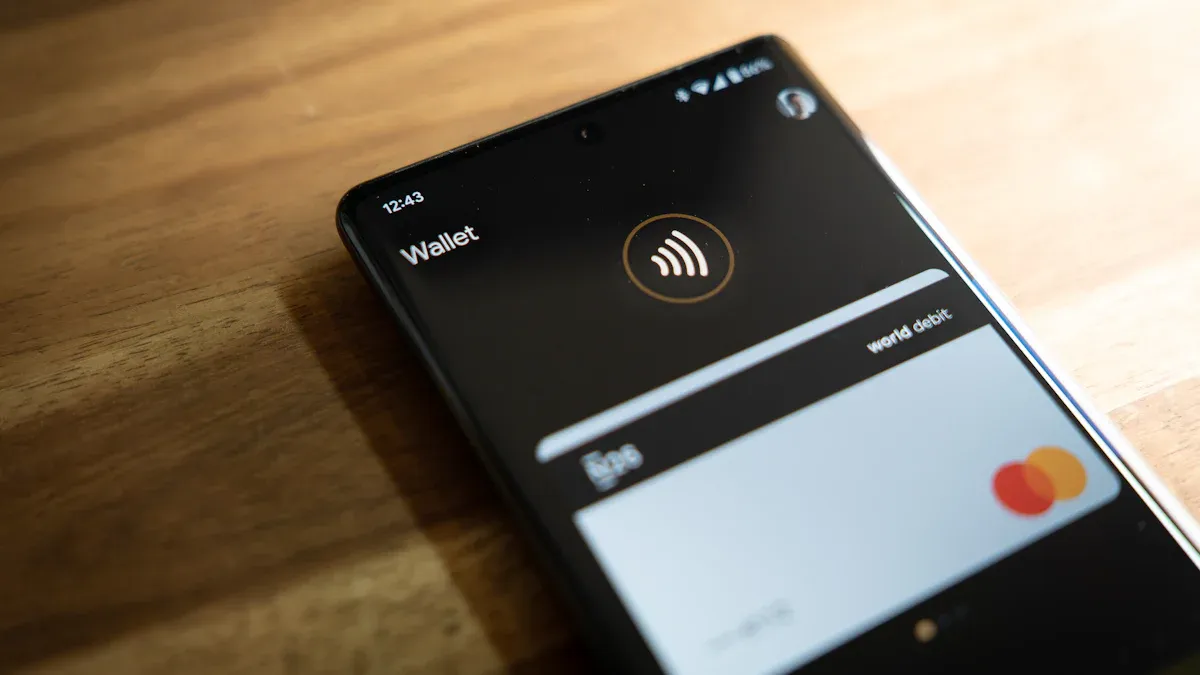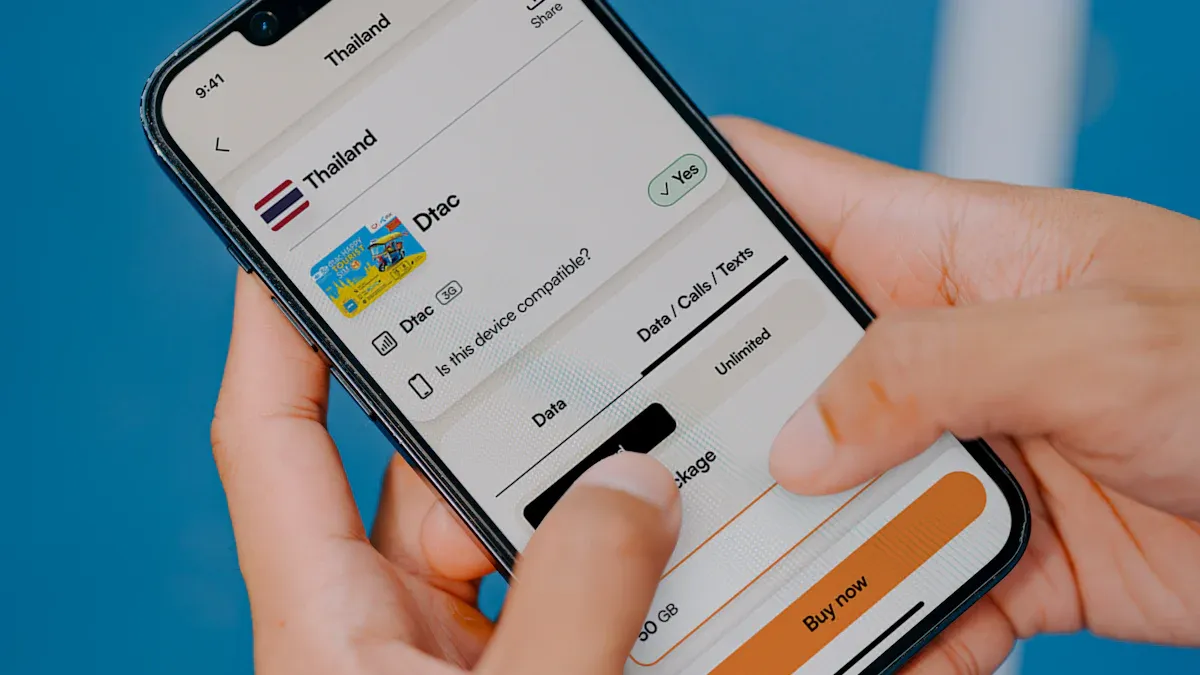- EasyCard
- Trade
- Help
- Announcement
- Academy
- SWIFT Code
- Iban Number
- Referral
- Customer Service
- Blog
- Creator
Can You Use Apple Pay Abroad? International Payment and Remittance Guide

Image Source: unsplash
Can Apple Pay be used abroad? The answer is yes, and its user experience is far more convenient than you might imagine.
You can primarily utilize it in two core scenarios:
- Making payments at thousands of stores.
- Sending remittances to individuals via specific apps.
This article provides a clear operational guide to help you understand usage conditions, fee structures, and specific steps, enabling seamless use abroad.
Key Points
- Apple Pay is available in nearly 100 countries and regions worldwide, with extensive coverage.
- Apple Pay has two main uses: direct in-store payments and international remittances via third-party apps.
- For in-store payments, your iPhone or Apple Watch doesn’t need an internet connection, but the merchant must support NFC payments.
- Apple Pay itself does not charge foreign transaction fees, but your linked bank card may incur currency conversion fees.
- When using Apple Pay for remittances, it serves as a secure payment tool, with the actual transfer handled by third-party services.
Can You Use Apple Pay Abroad: The Answer and Two Key Scenarios
You already know the answer is affirmative. Now, let’s dive into Apple Pay’s global reach and specific uses to give you a comprehensive understanding of the question, “Can you use Apple Pay abroad?”
Global Coverage
Apple Pay’s coverage is far broader than many realize. Since its launch in 2014, it has rapidly expanded to nearly 100 countries and regions worldwide.
This list includes popular travel and business destinations such as the United States, United Kingdom, Japan, Australia, Singapore, as well as Hong Kong, Macau, and Taiwan in China.
Apple has partnered with over 11,000 banks globally, providing a robust support network. Technically, as long as the merchant at your destination supports EMV contactless payment terminals based on NFC technology (commonly known as the “tap-to-pay” symbol), you have a high chance of successfully using Apple Pay to complete payments.
Two Core Uses
After understanding the coverage, you need to clearly distinguish Apple Pay’s two primary uses abroad. They differ entirely in principle and operation, and the table below clearly illustrates their distinctions:
| Use Case | Brief Description |
|---|---|
| Scenario 1: Merchant Payments | The most direct and common use. You can tap your iPhone or Apple Watch at NFC-enabled stores, restaurants, or transit systems to complete payments. |
| Scenario 2: Peer-to-Peer Remittances | An indirect use. When making international transfers via third-party remittance apps, you can select Apple Pay as the payment method for funding the transfer. Apple Pay itself does not execute the transfer but serves as a payment tool. |
In simple terms, one is for direct spending, and the other is for funding your “money transfer” action. Understanding these two scenarios helps you better grasp the operational guide that follows. So, regarding whether Apple Pay can be used abroad, the answer is not just “yes” but also how you leverage it based on different needs.
Scenario 1: Overseas Merchant Payments

Image Source: unsplash
This is the most straightforward way to use Apple Pay abroad. Whether buying a coffee at a café in Paris or shopping at a convenience store in Tokyo, you can complete payments by tapping your phone or watch, just as you would in mainland China. Below, we detail its usage conditions, process, and fees.
Usage Conditions
To successfully use Apple Pay for payments, both the merchant and you must meet certain basic conditions.
First, the merchant must support contactless payments. You can confirm this by:
- Looking for Symbols: Check for the Apple Pay logo or the universal contactless payment symbol (a wave-like icon resembling Wi-Fi) at the checkout counter or payment terminal.
- Asking Directly: If unsure, simply ask the cashier, “Do you accept Apple Pay?” for the easiest confirmation.
What Do Merchants Need? For physical stores, they need NFC-enabled payment terminals with up-to-date POS system software. For online shopping websites, they require a payment service provider that supports Apple Pay to process transactions.
Second, you need to prepare your device and bank card. For users in Hong Kong, many major banks offer support.
| Bank Name | Supported Card Types |
|---|---|
| Bank of China (Hong Kong) | Debit and Credit Cards |
| Bank of Communications (Hong Kong) Limited | Debit and Credit Cards |
| Bank of East Asia | Credit Cards |
| China Construction Bank (Asia) | Credit Cards |
| DBS Bank | Debit Cards |
| Hang Seng Bank | Credit Cards |
| HSBC | Debit and Credit Cards |
| ICBC (Asia) | Credit Cards |
| Standard Chartered Bank | Debit Cards |
For users in mainland China, you can add UnionPay credit or debit cards issued by major banks to your Wallet app for use at merchants abroad that support UnionPay contactless payments.
Payment Process
Once you confirm the merchant supports Apple Pay, the payment process is simple and fast. The steps vary slightly depending on the device used.
- Activate Wallet:
- If your iPhone supports Face ID, quickly double-press the side button.
- If your iPhone supports Touch ID, place your finger on the Home button (without pressing it).
- Authenticate Identity: Authorize the payment via Face ID, Touch ID, or entering a passcode.
- Complete Payment: Hold the top of your iPhone near the payment terminal’s contactless reader until the screen displays “Done” with a checkmark.
Paying with Apple Watch:
- Activate Wallet: Quickly double-press the side button. Your default card will automatically appear.
- Select Card: If you want to use a different card, scroll down to choose.
- Complete Payment: Hold the Apple Watch display near the payment terminal until you feel a gentle vibration and hear a confirmation sound.
Fee Structure
This is a question you’re likely concerned about: Will using Apple Pay abroad incur extra fees?
The answer is: Apple itself does not charge any foreign transaction fees.
The fees you encounter typically come from the issuing bank of your linked card. These are known as “currency conversion fees” or “foreign transaction fees” (Foreign Transaction Fee).
- Fee Source: When you use a CNY-based bank card to pay in a foreign currency (e.g., USD, EUR) abroad, the bank needs to perform currency conversion. This process incurs costs, which the bank passes on to you as a fee.
- Fee Rate: This fee is typically 1% to 3% of the transaction amount. For example, for a $100 USD purchase, you might pay $1 to $3 USD in fees, depending on your bank’s policy.
- Special Cases: If you use a card like Apple Card (primarily available in the US) that explicitly waives foreign transaction fees, you won’t incur this cost. However, if you pay via Apple Cash, you may be charged about 3% since it’s essentially a prepaid card.
Therefore, before traveling, it’s essential to confirm your issuing bank’s foreign transaction fee policy.
Preparation for Use
To ensure a smooth payment experience abroad, complete these simple preparations before departure:
- Check Wallet App: Ensure the bank card you plan to use is successfully added to the Wallet app on your iPhone or Apple Watch.
- Contact Your Bank: Call or check via your bank’s app to confirm whether your card supports international payments and understand the currency conversion fee rates.
- Verify Destination Support: Confirm that your travel destination is on Apple Pay’s supported countries and regions list.
- Familiarize with Payment Process: Get acquainted with the payment steps for your iPhone or Apple Watch to avoid fumbling at the checkout.
With these preparations, you can confidently enjoy Apple Pay’s convenient payment experience at stores worldwide.
Scenario 2: Cross-Border Peer-to-Peer Remittances

Image Source: unsplash
Now, let’s explore Apple Pay’s second major use abroad: sending cross-border remittances to family, friends, or individuals. This scenario differs from direct merchant purchases, and understanding its mechanics is crucial.
How It Works
First, you need to understand a core concept: Apple Pay itself does not directly provide international remittance services. It cannot independently complete a transfer from mainland China to the US, for example, like a bank or specialized remittance company.
So, how does it facilitate remittances? The answer is that Apple Pay acts as a secure and convenient “payment tool.” You use a third-party international remittance app (e.g., Wise or Remitly) to process the transfer, and when it’s time to fund the remittance, you can choose Apple Pay to complete the payment.
In simple terms, Apple Pay is like a “virtual credit card” used to pay for the remittance on the service platform. It leverages tokenization and biometric (Face ID or Touch ID) technology to provide a secure payment step without entering physical card details, but the actual cross-border transfer is handled by the third-party service.
These third-party services may charge transfer fees and currency conversion costs, so comparing providers’ fees is essential.
Operational Steps
While it sounds somewhat indirect, the actual process is seamless. Using Wise as an example, here are the specific steps. The process is similar for other remittance apps supporting Apple Pay, like Remitly.
- Download and Register App: First, download an international remittance app like Wise on your phone and complete the free account registration as guided.
- Set Up Transfer Details: Open the app, enter the amount you want to send, and select the destination country. The system will automatically display the current exchange rate, fees, and the exact amount the recipient will receive.
- Enter Recipient Information: Accurately input the recipient’s name, bank account details (e.g., IBAN or SWIFT/BIC code), and contact information. Depending on the destination country, you can also opt to send to a mobile wallet or arrange cash pickup.
- Select Apple Pay for Payment: At the payment stage, you’ll see various payment options, such as bank transfer, credit card, or debit card. Choose Apple Pay as your payment method.
- Verify and Confirm: After selecting Apple Pay, your iPhone will display a payment interface. Authorize the payment via Face ID or Touch ID, completing the process without manually entering card details.
- Track Your Transfer: After payment, you can track the transfer’s status in real-time within the app until the recipient successfully receives the funds.
Operational Tip Using Apple Pay to fund a remittance offers the biggest advantages in speed and security. It eliminates the hassle of digging out your wallet or entering lengthy card details, allowing authorization in seconds while keeping your actual card number hidden from the remittance platform.
Supported Services
Many excellent international remittance services have integrated Apple Pay, offering you a wide range of choices. They vary in fees, speed, and supported countries.
The table below lists some mainstream remittance services that support Apple Pay for reference:
| Service Name | Key Features | Supports Apple Pay |
|---|---|---|
| Wise | Known for near-mid-market exchange rates and low, transparent fees, with fast delivery. | Yes |
| Remitly | Offers multiple receipt methods (bank deposits, cash pickups, etc.) with clear fee structures, suitable for various needs. | Yes |
| Revolut | Competitive exchange rates, supports transfers to over 140 countries, with additional benefits for premium users. | Yes |
| WorldRemit | Extensive global network, supports over 130 countries, with flexible receipt options. | Yes |
Fees and Limits
When using Apple Pay for cross-border remittances, the fees you need to focus on come from two sources: the remittance service provider and your issuing bank.
- Remittance Service Fee: This is a fixed or percentage-based fee charged by the platform (e.g., Wise, Remitly) for processing your transfer.
- Currency Conversion Margin: Some providers add a hidden profit margin to the exchange rate. Opt for platforms like Wise that use mid-market rates and clearly disclose fees.
- Payment Method Surcharge: This is a critical point. When you use a credit card via Apple Pay to fund the remittance, the service provider may charge an additional fee. For example, Wise notes that using a credit card incurs about a 2% surcharge, paid to the credit card company. In contrast, using a debit card is typically cheaper.
Fee Warning Before clicking “confirm transfer,” carefully review all fees on the app’s fee breakdown page. For a $1,000 USD transfer, a 2% surcharge means an extra $20 USD cost.
Regarding limits, these are primarily determined by the remittance service provider, not Apple Pay. Limits typically depend on:
- Your account verification level (providing more identity information can increase limits).
- The destination country.
- The chosen payment method.
Therefore, before sending large amounts, check the specific limit policies in the app’s help center.
Common Questions and Safety Tips
After learning how to use Apple Pay abroad, you may still have questions about network requirements, security, and payment failures. This section addresses these common concerns to help you use it with confidence.
Network Requirements
A common question is: Do I need an internet connection to use Apple Pay in stores abroad?
The answer is: No. When making in-store payments, your iPhone or Apple Watch does not require Wi-Fi or cellular data.
Apple Pay uses NFC (Near Field Communication) technology. This short-range wireless technology allows your device to communicate directly with the merchant’s payment terminal. When you authorize a payment, the secure element in your device generates a unique transaction code sent to the terminal, a process that doesn’t rely on the internet. However, you do need an internet connection initially to add a bank card to the Wallet app.
Handling Payment Failures
Occasionally, you may encounter payment failures. These are typically not issues with Apple Pay itself but may stem from:
- Bank Restrictions: Your issuing bank may not have authorized the card for international purchases.
- Poor Connection: The NFC connection may fail if your device is too far from or misaligned with the payment terminal.
- Outdated Information: The bank card added to your Wallet may have expired.
- Device Issues: Low battery or temporary software glitches.
If a payment fails, try holding your device closer to the terminal or switch to another card. If the issue persists, contact your issuing bank to confirm the card’s status.
Account Security
- Tokenization: Your actual card number is never stored on the device or sent to merchants. Apple Pay creates a unique “Device Account Number” (token) for your card. Each transaction uses this token, effectively preventing card number leaks.
- Biometric Authentication: Every payment requires authentication via Face ID or Touch ID, ensuring only you can authorize transactions.
What If Your Device Is Lost? If your iPhone or Apple Watch is lost during travel, immediately use the Find My feature to set the device to Lost Mode. This action instantly locks the device and suspends all cards used via Apple Pay, effectively safeguarding your funds.
Bank Card Support
Apple Pay typically supports mainstream bank card types, offering flexibility for payments abroad.
- Credit Cards
- Debit Cards
- Prepaid Cards
While Apple Pay supports these cards, not all bank-issued cards are automatically enabled for international payments. Therefore, before traveling, confirm with your issuing bank (e.g., HSBC, Standard Chartered) whether your card is supported in the destination country and inquire about any potential fees.
Now, you have a clear answer to the question, “Can you use Apple Pay abroad?” With its convenience, security, and growing global coverage, it’s an ideal international payment companion.
You just need to remember its two main roles:
- Direct in-store payments.
- A payment tool for third-party apps to complete remittances.
With Apple Pay projected to account for 10% of global card transactions by 2025, preparation is key. Before departure, follow this guide to check your bank and destination support. This way, you can fully address the question, “Can you use Apple Pay abroad?” and use it with confidence.
FAQ
You may have specific questions after reading this guide. Here are answers to some of the most common ones to help you use Apple Pay with peace of mind.
Do I Need an Internet Connection for In-Store Payments?
You don’t need an internet connection for in-store payments. Apple Pay uses NFC technology to communicate with the payment terminal. This process doesn’t rely on Wi-Fi or cellular data, allowing smooth payments even in areas without signal.
What If My iPhone Is Lost Abroad?
You should immediately use the Find My feature to set your device to Lost Mode.
This action instantly suspends Apple Pay functionality on your device, protecting your funds. Your physical bank cards remain usable.
Can I Use Apple Pay for Online Shopping on Foreign Websites?
Yes. Many foreign e-commerce websites and apps support Apple Pay. You can select Apple Pay as a payment method at checkout, making it convenient and secure without manually entering card details.
Can I Use Apple Pay to Withdraw Cash at ATMs?
Yes, if the ATM supports contactless withdrawals. Look for ATMs with the contactless payment symbol (a wave-like icon resembling Wi-Fi). Hold your phone near the reader to operate it like a card tap.
*This article is provided for general information purposes and does not constitute legal, tax or other professional advice from BiyaPay or its subsidiaries and its affiliates, and it is not intended as a substitute for obtaining advice from a financial advisor or any other professional.
We make no representations, warranties or warranties, express or implied, as to the accuracy, completeness or timeliness of the contents of this publication.




Contact Us
Company and Team
BiyaPay Products
Customer Services
is a broker-dealer registered with the U.S. Securities and Exchange Commission (SEC) (No.: 802-127417), member of the Financial Industry Regulatory Authority (FINRA) (CRD: 325027), member of the Securities Investor Protection Corporation (SIPC), and regulated by FINRA and SEC.
registered with the US Financial Crimes Enforcement Network (FinCEN), as a Money Services Business (MSB), registration number: 31000218637349, and regulated by FinCEN.
registered as Financial Service Provider (FSP number: FSP1007221) in New Zealand, and is a member of the Financial Dispute Resolution Scheme, a New Zealand independent dispute resolution service provider.



















